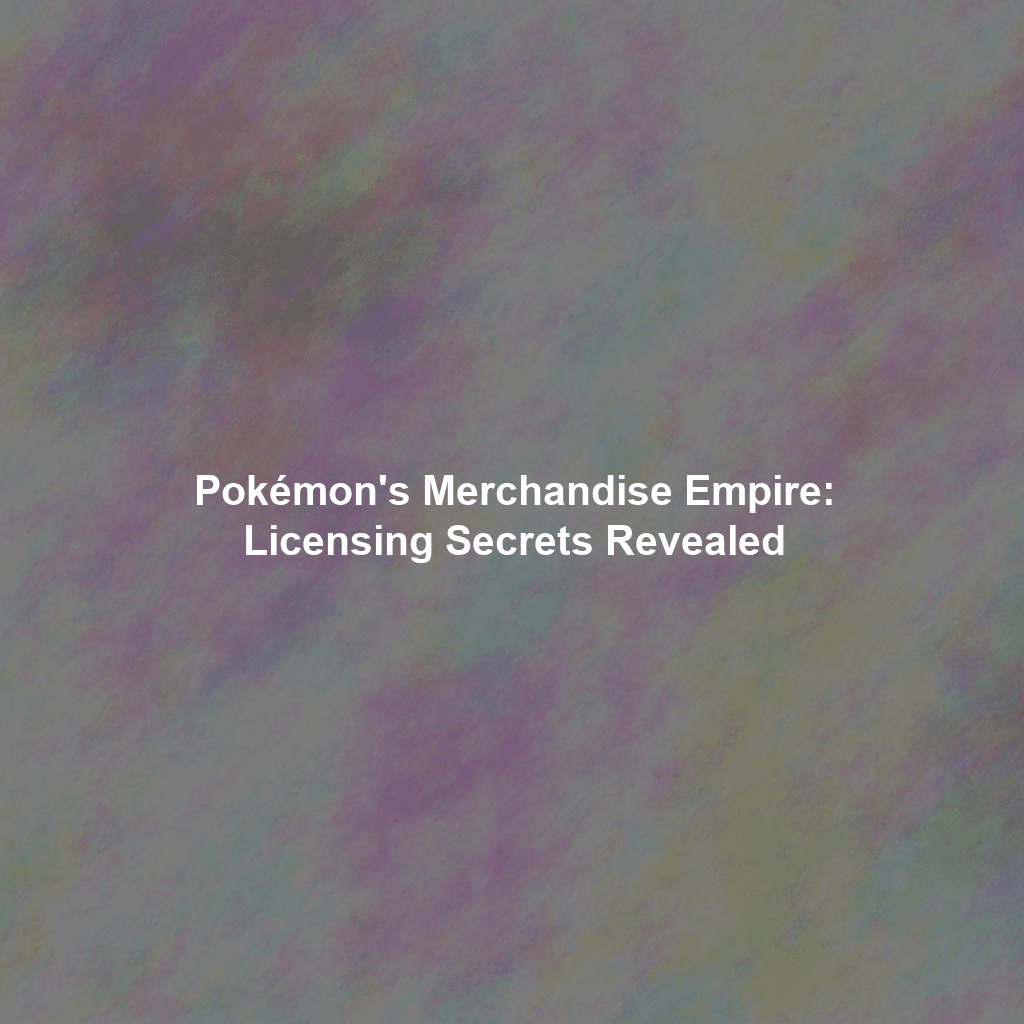Beyond Ash & Pikachu: The Foundations of a Licensing Colossus
Pokémon’s success isn’t just about catchy characters and engaging gameplay; it’s about a meticulously crafted licensing strategy that extends the brand’s reach far beyond the Nintendo consoles. The Pokémon Company International, responsible for managing the brand outside of Japan, has masterfully leveraged licensing to build a diversified revenue stream and cultivate a loyal fanbase across generations.
Understanding the nuances of the Pokémon licensing strategy requires looking beyond surface-level brand recognition. It’s about understanding the target audience, maintaining quality control, and strategically aligning with brands that complement the Pokémon universe.
The Core Pillars of Pokémon’s Licensing Strategy
- Brand Consistency: Maintaining a consistent brand image across all licensed products is paramount. This includes adhering to strict style guides and approval processes to ensure quality and prevent brand dilution.
- Targeted Demographics: Pokémon understands its diverse audience, from young children to nostalgic adults. Licensing efforts are tailored to appeal to specific age groups and interests.
- Strategic Partnerships: Collaborations with well-known brands allow Pokémon to tap into existing customer bases and expand its reach into new markets.
- Diversification: Pokémon merchandise spans a vast range of categories, from traditional toys and collectibles to apparel, accessories, food, and even travel experiences.
- Global Reach: A carefully planned global expansion strategy ensures that Pokémon merchandise is available in markets worldwide, with localized adaptations to cater to cultural nuances.
Diversification is Key: Exploring Pokémon’s Merchandise Universe
Pokémon’s merchandise empire isn’t built on just one type of product. It’s a carefully curated collection spanning a wide range of categories, ensuring there’s something for everyone.
Toys & Collectibles: The Heart of the Pokémon Brand
From plush toys featuring Pikachu and other iconic Pokémon to trading cards and action figures, toys and collectibles remain the cornerstone of the Pokémon licensing program. The Pokémon Trading Card Game (TCG) alone generates billions of dollars in revenue annually and continues to be a major driver of brand awareness and engagement. The rarity and collectibility aspects of the cards contribute significantly to their value and appeal.
Example: The Pokémon TCG has seen consistent growth, with special edition sets and collaborations driving significant sales spikes. The demand often outstrips supply, leading to significant resale value for rare cards. (Source: Statista – Pokémon TCG card sales worldwide)
Apparel & Accessories: Wearing Your Pokémon Pride
Pokémon-themed apparel and accessories allow fans to express their love for the franchise through everyday wear. This category includes everything from t-shirts and hoodies to hats, bags, and jewelry, often featuring popular Pokémon characters and logos.
Example: Collaborations with fashion brands like UNIQLO and Adidas have been highly successful, introducing Pokémon apparel to a wider audience and reinforcing the brand’s appeal across different age groups. (Source: Highsnobiety – UNIQLO Pokémon Collections)
Home & Lifestyle: Pokémon in Every Corner
Pokémon’s licensing extends beyond personal items into the home and lifestyle category. This includes bedding, furniture, kitchenware, and even themed home decor, allowing fans to immerse themselves in the Pokémon world within their living spaces.
Example: Pokémon-themed home goods are readily available through retailers like Target and Walmart, offering affordable options for fans to incorporate their favorite characters into their home decor. Themed bedding and plush furniture are especially popular among younger audiences.
Food & Beverage: A Taste of Pokémon
Pokémon has also ventured into the food and beverage industry, partnering with companies to create themed snacks, drinks, and even restaurant experiences. This category provides a unique and engaging way for fans to interact with the brand.
Example: McDonald’s Happy Meals featuring Pokémon toys and cards are a recurring and highly successful promotion, driving traffic to restaurants and generating significant buzz around the brand. (Source: PR Newswire – McDonald’s Pokémon Happy Meal)
Digital Merchandise: Pokémon Goes Virtual
In the digital realm, Pokémon offers a variety of virtual merchandise, including in-game items, avatar customizations, and digital collectibles. This category caters to the growing popularity of digital assets and provides new avenues for revenue generation.
Example: Pokémon GO offers in-app purchases for items that enhance gameplay, such as Poké Balls, Incense, and Raid Passes. These digital items generate significant revenue for Niantic, the game’s developer, and contribute to the overall Pokémon ecosystem.
Strategic Partnerships: Powering Pokémon’s Expansion
Pokémon’s licensing success is heavily reliant on strategic partnerships with established brands across various industries. These collaborations allow Pokémon to leverage the partners’ existing customer base, distribution channels, and marketing expertise to reach new audiences and expand its brand presence.
Key Partnership Strategies:
- Co-Branding: Creating products that combine the Pokémon brand with the partner’s brand, appealing to both fan bases.
- Limited-Edition Collaborations: Generating excitement and exclusivity through limited-edition products that drive demand.
- Cross-Promotion: Leveraging each partner’s marketing channels to promote the collaboration and reach a wider audience.
- Event Sponsorships: Sponsoring events and tournaments to engage with fans and promote the brand.
Notable Pokémon Partnerships:
- McDonald’s: Recurring Happy Meal promotions featuring Pokémon toys and cards.
- UNIQLO: Collections of Pokémon-themed apparel.
- Adidas: Collaborations on Pokémon-themed sneakers and apparel.
- Build-A-Bear Workshop: Customizable Pokémon plush toys.
- General Mills: Pokémon-themed breakfast cereals.
- The Wand Company: High-end prop replicas and collectibles
Why these partnerships work: Pokémon carefully selects partners that align with its brand values and target audience. The collaborations are often strategically timed to coincide with major events, such as new game releases or movie premieres, maximizing their impact and generating significant media coverage.
Maintaining Brand Integrity: Quality Control in the Pokémon Universe
With such a vast and diverse licensing program, maintaining brand integrity is crucial for Pokémon’s long-term success. The Pokémon Company International has implemented strict quality control measures to ensure that all licensed products meet its standards for design, materials, and overall quality.
Key Quality Control Measures:
- Style Guides: Providing detailed style guides to licensees, outlining specific guidelines for using Pokémon characters, logos, and artwork.
- Approval Processes: Requiring licensees to submit product designs and samples for approval before production.
- Factory Audits: Conducting regular factory audits to ensure that licensees are adhering to ethical and environmental standards.
- Anti-Counterfeiting Measures: Actively combating counterfeit products to protect the brand and prevent consumer deception.
The Importance of Quality Control: Maintaining consistent quality across all licensed products helps to reinforce the Pokémon brand’s reputation for excellence and builds trust with consumers. It also protects the intellectual property rights of The Pokémon Company International and prevents the proliferation of substandard or harmful products.
Beyond the Hype: The Enduring Power of the Pokémon Brand
Pokémon’s licensing success is not merely a result of clever marketing tactics; it’s rooted in the enduring appeal of the brand itself. The characters are beloved for their unique designs and personalities, and the games offer engaging gameplay that appeals to a wide range of ages and skill levels.
Factors Contributing to Pokémon’s Enduring Appeal:
- Nostalgia: Pokémon holds a special place in the hearts of many adults who grew up with the franchise in the 1990s.
- Collectibility: The Pokémon Trading Card Game and other collectibles tap into the human desire for collecting and completing sets.
- Community: Pokémon fosters a strong sense of community among fans, who connect through online forums, tournaments, and other events.
- Innovation: The Pokémon Company International continues to innovate and evolve the franchise, introducing new games, characters, and experiences to keep fans engaged.
Pokémon has successfully transcended generations and continues to be a cultural phenomenon. Its ability to adapt to changing trends and technologies while staying true to its core values has ensured its long-term success.
Conclusion: Lessons from the Pokémon Licensing Empire
Pokémon’s licensing program serves as a powerful case study for any company looking to expand its brand reach and generate revenue through merchandise. By focusing on brand consistency, targeted demographics, strategic partnerships, and quality control, The Pokémon Company International has built a multi-billion dollar licensing empire that continues to thrive.
Key Takeaways for Building a Successful Licensing Program:
- Understand Your Target Audience: Tailor your merchandise offerings to appeal to specific age groups and interests.
- Build Strong Partnerships: Collaborate with established brands that align with your values and target audience.
- Maintain Brand Integrity: Implement strict quality control measures to ensure that all licensed products meet your standards.
- Embrace Innovation: Continuously explore new opportunities and adapt to changing trends.
- Cultivate Community: Foster a strong sense of community among your fans.
By implementing these strategies, you can unlock the full potential of your brand and build a successful licensing program that drives revenue and expands your reach.
 Skip to content
Skip to content

